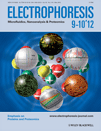
ELECTROPHORESIS
Scope & Guideline
Advancing the Frontiers of Electrophoretic Science
Introduction
Aims and Scopes
- Capillary Electrophoresis Techniques:
The journal extensively covers advancements in capillary electrophoresis (CE), including novel methodologies for separating biomolecules like proteins, nucleic acids, and small molecules. - Applications in Forensic Science:
ELECTROPHORESIS publishes research on the application of electrophoretic techniques in forensic science, particularly for DNA analysis, body fluid identification, and genetic profiling. - Microfluidic Systems:
The journal emphasizes microfluidic technologies and their integration with electrophoresis for enhanced separation and analysis of biological samples, highlighting innovations in device design and operation. - Mass Spectrometry Coupling:
Research articles often explore the coupling of electrophoresis with mass spectrometry (MS) to improve analytical sensitivity and specificity, particularly in the analysis of complex biological matrices. - Environmental and Food Analysis:
ELECTROPHORESIS features studies on the use of electrophoretic methods for environmental monitoring and food safety, addressing the detection of contaminants and the analysis of food products. - Nanoparticle and Surface Interactions:
The journal includes research on the interactions of nanoparticles with biological systems, focusing on electrokinetic phenomena and their applications in drug delivery and biosensing.
Trending and Emerging
- Integration of AI and Machine Learning:
There is an increasing trend towards utilizing artificial intelligence and machine learning to optimize electrophoretic techniques and analyze complex data sets, enhancing the efficiency of analytical methods. - Biopharmaceutical Applications:
The journal is seeing a rise in research focused on the application of electrophoresis in biopharmaceutical development, particularly in characterizing protein therapeutics and biosimilars. - Sustainable and Green Chemistry:
Emerging studies emphasize sustainable practices in electrophoretic methods, including the development of eco-friendly solvents and materials, aligning with global trends in green chemistry. - Electrophoresis in Clinical Diagnostics:
There is a notable increase in research applying electrophoresis techniques to clinical diagnostics, particularly in the analysis of biomarkers for diseases, reflecting a growing intersection with healthcare. - Electrophoretic Microfluidics:
The trend towards miniaturization and integration of electrophoresis with microfluidic technologies is expanding, leading to innovative applications in point-of-care testing and diagnostics.
Declining or Waning
- Traditional Gel Electrophoresis:
The use of traditional gel electrophoresis techniques has decreased as newer, more efficient methods such as capillary electrophoresis gain favor for their speed and resolution. - Basic Electrophoresis Theory:
There is a noticeable reduction in publications focusing solely on fundamental theories of electrophoresis, as the field shifts towards applied research and practical applications. - Simple Electrophoresis Applications:
Research that merely applies standard electrophoresis techniques without innovative approaches or significant improvements has become less common, as the journal prioritizes novel methodologies.
Similar Journals
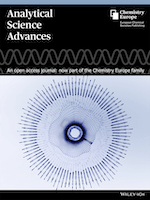
Analytical Science Advances
Pioneering Research for Tomorrow's Analytical ChallengesAnalytical Science Advances is a dynamic journal published by WILEY, dedicated to the ever-evolving field of analytical chemistry. With an ISSN of 2628-5452, this open-access platform aims to disseminate high-quality research and insightful reviews that push the boundaries of analytical methodologies and instrumentation. Since its inception in 2020, the journal has gained traction, securing a commendable Q2 ranking in 2023 within its category, highlighting its significance in the scientific community. Currently positioned at Rank #68 out of 156 in Scopus' analytical chemistry category, it boasts a 56th percentile ranking, reflecting its contributions to advancing analytical techniques. Researchers, professionals, and students will find this journal an invaluable resource for keeping abreast of the latest developments, emerging technologies, and innovative approaches in analytical science, ensuring the journal's relevancy and influence in shaping future discoveries.

MOLECULAR & CELLULAR PROTEOMICS
Transforming proteomics with high-impact research.MOLECULAR & CELLULAR PROTEOMICS, published by Elsevier, stands as a premier journal in the fields of Biochemistry, Analytical Chemistry, and Molecular Biology, with a distinguished Q1 ranking reflecting its high impact and contribution to the scientific community. Established in 2002, this journal has consistently provided a platform for the latest research in protein science, merging molecular biology with advanced analytical techniques. With impressive Scopus rankings—41st in Biochemistry and 16th in Analytical Chemistry—it caters to an audience of researchers, professionals, and students eager to explore cutting-edge developments in proteomics. Although currently not designated as open access, the journal aims to foster knowledge dissemination through accessible research content. As it continues to evolve until 2024, MOLECULAR & CELLULAR PROTEOMICS is essential for anyone passionately engaged in the ever-expanding field of proteomics.
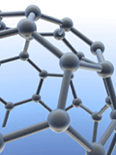
Annual Review of Analytical Chemistry
Empowering Researchers with Cutting-Edge InsightsAnnual Review of Analytical Chemistry, published by Annual Reviews, is a premier journal that serves as a critical resource in the field of analytical chemistry, providing comprehensive and cutting-edge reviews that synthesize recent advancements and pivotal research findings. With an impressive impact factor and ranked Q1 in both Analytical Chemistry and Miscellaneous Medicine, it stands as a leader in disseminating knowledge that spans the intricacies of chemical analysis, enhancing the scientific discourse within the community. Available in both print (ISSN: 1936-1327) and online (E-ISSN: 1936-1335), the journal is accessible to a wide audience, fostering innovation and collaboration among researchers, professionals, and students alike. Its scope includes the converged years from 2008 to 2024, showcasing its commitment to providing relevant and timely insights that impact practice and education in analytical techniques, methodologies, and applications. The Scopus rank of #6 out of 156 in Analytical Chemistry, placing it in the 96th percentile, underscores its significance and the high regard in which it is held. As you explore the journal's offerings, you will find a wealth of knowledge that not only informs but inspires future discoveries in the realm of analytical chemistry.

Analytical Science and Technology
Unveiling new horizons in analytical methodologies and applications.Analytical Science and Technology is a prominent journal dedicated to advancing the fields of analytical chemistry and technology, published by the Korean Society for Analytical Science. Based in South Korea, this journal serves as a vital platform for researchers, professionals, and students committed to exploring innovative analytical techniques and methodologies. Although it is classified under Q4 in various subject categories, including Agronomy and Crop Science, Environmental Chemistry, and Pharmacology, the journal aims to provide critical insights and contributions to the scientific community. With ISSN 1225-0163 and E-ISSN 2288-8985, it spans a converged timeline from 2019 to 2024. Despite its current standings in Scopus rankings, the journal is dedicated to improving its visibility and impact through rigorous peer review and high-quality publications, fostering knowledge sharing within its diverse academic fields. Researchers looking for a reliable outlet for their findings are encouraged to consider this journal as it continues to strive for excellence in analytical science.

Forensic Toxicology
Unraveling the Mysteries of Toxic SubstancesForensic Toxicology is a premier journal published by Springer, renowned for delivering cutting-edge research in the realms of toxicology, biochemistry, and forensic medicine. With an ISSN of 1860-8965 and an E-ISSN of 1860-8973, this journal has established itself as a significant resource for professionals, researchers, and students engaged in the analysis of toxic substances within a forensic context. Its impressive impact factor and ranking reveal its influential presence in the field, particularly as it is categorized in Q1 for Pathology and Forensic Medicine and Q2 for Biochemistry (Medical) and Toxicology. Featured articles span a wide array of topics, facilitating interdisciplinary collaboration and advancing scientific knowledge. While currently not an open-access journal, it remains accessible through institutional subscriptions. With a convergence span from 2006 to 2024, Forensic Toxicology is committed to publishing high-quality research that enhances the understanding of toxicological phenomena and their implications in forensic investigations, reinforcing its role as an indispensable resource in the scientific community.
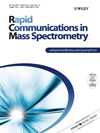
RAPID COMMUNICATIONS IN MASS SPECTROMETRY
Innovative insights for a dynamic field.RAPID COMMUNICATIONS IN MASS SPECTROMETRY is a leading journal published by Wiley, focusing on the rapidly evolving field of mass spectrometry and its applications across various domains, including analytical, organic, and spectroscopy chemistry. With its ISSN 0951-4198 and an E-ISSN of 1097-0231, the journal has firmly established itself as a reputable source of innovative research since its inception in 1987, and is set to continue until 2024. As evidenced by its 2023 Scopus rankings, the journal occupies a solid position in the realms of analytical chemistry (Q3), organic chemistry (Q3), and spectroscopy (Q3), reflecting its impact among a diverse audience of researchers and professionals. Although it is not an open-access publication, the findings shared within its pages are pivotal for advancing knowledge and practical applications in mass spectrometry, making it an essential resource for students and experts aiming to stay abreast of the latest scientific developments.
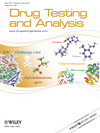
Drug Testing and Analysis
Transforming Drug Testing Through Cutting-Edge ResearchDrug Testing and Analysis is a leading scholarly journal published by WILEY, dedicated to advancing the field of drug testing and analytical methods. With ISSN 1942-7603 and E-ISSN 1942-7611, this journal provides a platform for the latest research in Analytical Chemistry, Pharmaceutical Science, and Environmental Chemistry, holding a prestigious reputation reflected in its Q1 and Q2 rankings across various categories in 2023. The journal promotes high-impact studies that explore innovative methodologies, with a specific focus on pharmacological and toxicological analyses, making it an essential resource for researchers, professionals, and students concerned with drug efficacy, safety, and environmental impact. With a strong commitment to quality and relevance, Drug Testing and Analysis remains at the forefront of contemporary scientific inquiry, contributing significantly to both academic and practical advancements in the industry.

Brazilian Journal of Analytical Chemistry
Pioneering Analytical Methodologies for a New EraBrazilian Journal of Analytical Chemistry, published by VISAO FOKKA COMMUNICATION AGENCY, serves as a vital platform for those engaged in the field of analytical chemistry, especially within the Latin American context. With an ISSN of 2179-3425 and an E-ISSN of 2179-3433, this journal aims to promote high-quality research and advancements in analytical methodologies, instrumentation, and applications spanning from 2010 to the present. Although it currently holds a Q4 rank in Analytical Chemistry by Scopus and is placed at the 24th percentile, its commitment to open access publishing provides invaluable opportunities for widespread dissemination of knowledge, catering to researchers, professionals, and students alike. The journal's editorial board comprises emerging and established experts aiming to bridge gaps in analytical chemistry research, particularly in a Brazilian and broader South American context. Situated in São Paulo, Brazil, the journal's role in fostering innovation and collaboration in analytical techniques makes it an essential resource for the academic community.

Chinese Journal of Chromatography
Transforming Challenges into Solutions through ChromatographyChinese Journal of Chromatography, published by SCIENCE PRESS, is a dedicated platform for disseminating pioneering research in the fields of Analytical Chemistry, Biochemistry, and Organic Chemistry. Established in 1997, this esteemed journal offers invaluable insights into chromatographic techniques and their applications, showcasing studies that contribute to the advancement of chemical engineering and electrochemistry. Although it currently holds a Q4 ranking in several categories, the journal aims to foster growth and knowledge among researchers, professionals, and students alike. With a continuous publication window extending until 2024, the Chinese Journal of Chromatography invites submissions that not only enhance scientific understanding but also address real-world challenges through innovative chromatographic solutions. Researchers looking for a collaborative community will find this journal a vital resource in their ongoing academic endeavors.

Forensic Chemistry
Exploring the intersection of science and law.Forensic Chemistry is a premier journal published by Elsevier, specializing in the interdisciplinary field of forensic science, with a strong emphasis on analytical and materials chemistry, pathology, and law. Established in 2016 and converging to a significant publication trajectory through 2024, the journal has rapidly ascended to an impressive Q1 ranking across multiple categories, demonstrating its impact and commitment to advancing forensic analysis and methodologies. With an impact factor reflecting its relevance—especially notable with a 95th percentile rank in Social Sciences and Law—Forensic Chemistry serves as an essential resource for researchers, legal authorities, and academics seeking to explore the latest developments in forensic techniques and applications. Its rigorous peer-review process and high-quality publications ensure that it remains at the forefront of scientific inquiry in forensic practices. Access to the journal is available without an open access model, further emphasizing its commitment to curated, high-impact scholarship that contributes to both theoretical foundations and practical applications in the forensic field.